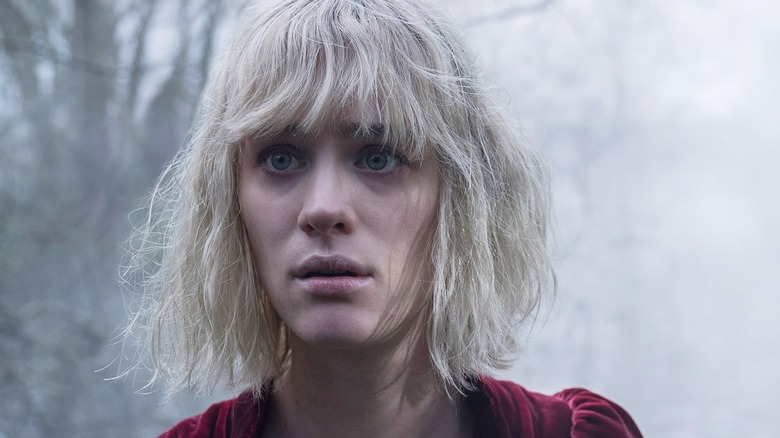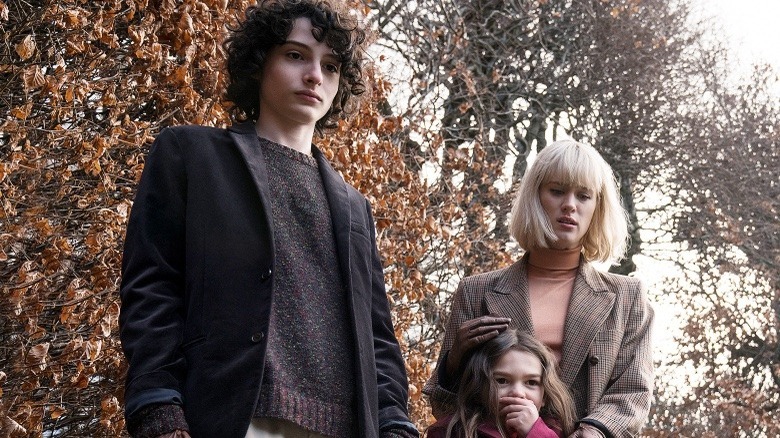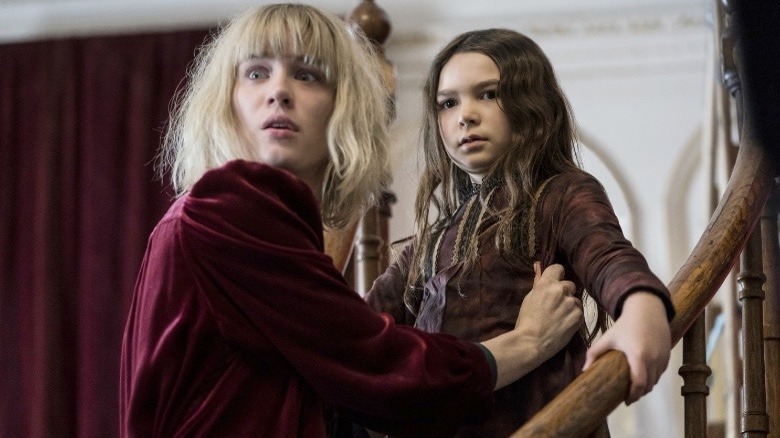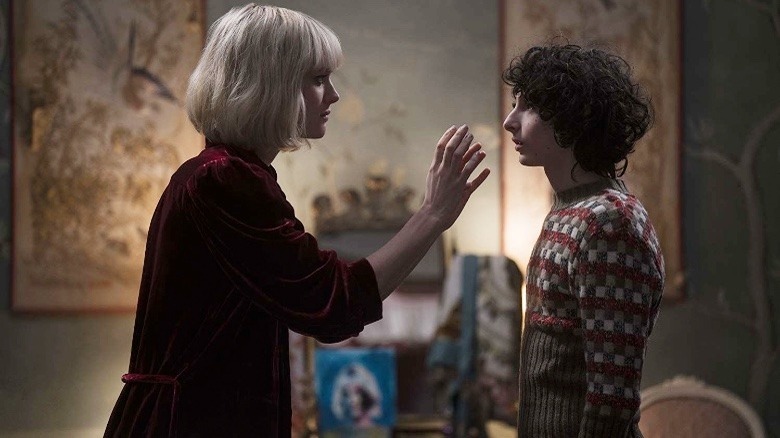The Turning Ending Explained: Is This Movie Really That Bad?
There's a fair chance more people have heard about "The Turning" (more specifically, its ending) being terrible than have actually seen the film. Adapted from Henry James' classic Gothic horror novella "The Turn of the Screw," the movie was once called "Haunting" and was meant to mark Steven Spielberg's triumphant return to the horror genre as a producer. Instead, it went through a bumpy pre-production that led to the film's original title, cast, and crew being dropped before shooting began on a revamped version of the project under Floria Sigismondi's direction. "The Turning" then saw its release date pushed back 11 months to January 2020, where it flopped at the box office and received mostly bad reviews.
The movie stars Mackenzie Davis as Kate Mandell, a young woman who's hired to act as a governess for two children, Miles (Finn Wolfhard) and Flora Fairchild (Brooklyn Prince), at their manor in the Maine countryside after the deaths of their parents in a car accident. There's a decent (if uneven) mood piece for its first two-thirds; some clunky jump scares aside, Sigismondi succeeds at infusing "The Turning" with a stylishly creepy aesthetic that recalls her grunge music videos from the '90s and '00s, while Davis acts convincingly terrified as someone trapped in a spooky, possibly haunted house packed with nightmare fuel like sinister paintings and dolls with broken faces. Problem is, the film's third act drops the ball so badly it's hard to appreciate much of what came before it.
The Ending of The Turning
Upon starting her new job, Kate quickly realizes the Fairchild kids are not alright and begins seeing the ghosts of their former live-in teacher, Miss Jessel, and horse riding instructor Peter Quint. After receiving some unsettling artwork from her mother, who is mentally ill and resides in an institution, Kate discovers that Peter sexually assaulted and murdered Miss Jessel before dying in an incident orchestrated by Mrs. Grose, the estate's caretaker.
As those familiar with "Turn of the Screw" have surely noted, "The Turning" puts a far darker spin on Miss Jessel and Peter's relationship than other adaptations. It also reveals that Miles learned much of his own toxic behavior from Peter (whose ghost pressures him to torment Kate), similar to how Flora is traumatized from witnessing her parents' death and losing Miss Jessel. This explains why the lonely duo struggle yet clearly yearn to bond with Kate — who's likewise haunted by her father abandoning her as a child and her mother's condition — and even flee their home with her after Peter's ghost kills Mrs. Grose.
Except, they don't. "The Turning" then reveals everything that happened after Kate received her mom's art was a vision she had triggered by Mrs. Grose saying she hopes her mom's condition isn't genetic. Miles and Flora later mock Kate and deny being able to see Peter's ghost, triggering Kate to imagine visiting what appears to be her mother. However, when they turn around to face her, Kate screams.
What the Heck Is That Supposed to Mean?
Naturally, Sigismondi has avoided clarifying what the film's purposely ambiguous ending really means, telling Collider that it speaks to "the thematic idea of being locked in with this trauma that you're dealing with." She also said her intent was to subvert the Hysterical Woman trope that was popular when James penned "Turn of the Screw" by being "gentle" to Kate and telling "a more emotional story."
It's not hard to follow Sigismondi's meaning. As indicated earlier, the characters in "The Turning" are all "locked in" with their trauma in some way. This is why it matters that the movie takes place in 1994: without the Internet or related tech, Kate, Flora, and Miles are all the more isolated in a house that's haunted by the specters (figurative or otherwise) of those who once lived there.
Yet, because the ending to "The Turning" is so abrupt and unclear, it doesn't enrich the movie's themes about cycles of abuse and trauma. Instead, it comes across as anticlimactic at best and, at worst, makes the film's use of sexual assault and mental illness as plot points feel exploitive in hindsight. What's more, "The Turning" explicitly shows the audience key details (namely, Peter attacking Miss Jessel in its prologue and a possessed mannequin turning its head) from a perspective other than Kate's. So, when its ending later insinuates that she may've imagined most of the movie's story, it only muddies the water in a bad way.
The Turning's Alternate Ending
The alternate ending to "The Turning" (which Universal unveiled on Blu-ray) has Peter's ghost attacking Kate, who fights him off and chokes him until Flora rushes in, begging her to stop. It's then revealed that "Peter" is actually Miles, who looks dead ... until (from Kate's POV) a giant spider emerges from his mouth and he bursts back to life. Relieved, Flora hugs her brother and then Kate as though nothing's wrong. Miles, on the other hand, gives Kate a look that's tricky to discern before the scene ends with Kate screaming.
Although this alternate conclusion doesn't magically fix all the problems with "The Turning," it feels more like a true ending than the official version and paints Kate in a sympathetic light (like Sigismondi wanted), yet avoids clarifying whether Miles was really being controlled by Peter. That might've also been an interesting way for "The Turning" to update the ambiguity inherent to the supernatural elements of James' novella and set it apart from other, more revered adaptations.
As for why this ending was dropped: perhaps Sigismondi found it too clear-cut or even "happy" compared to the climax to "The Turn of the Screw" (where Miles mysteriously dies after his governess shields him from Peter's ghost). Stranger yet, the skin-crawling visual of Miles coughing up a spider appeared in the film's official trailer, asking the question of when, precisely, it was abandoned. Like so much of "The Turning," it's both an enigma and a mess.



